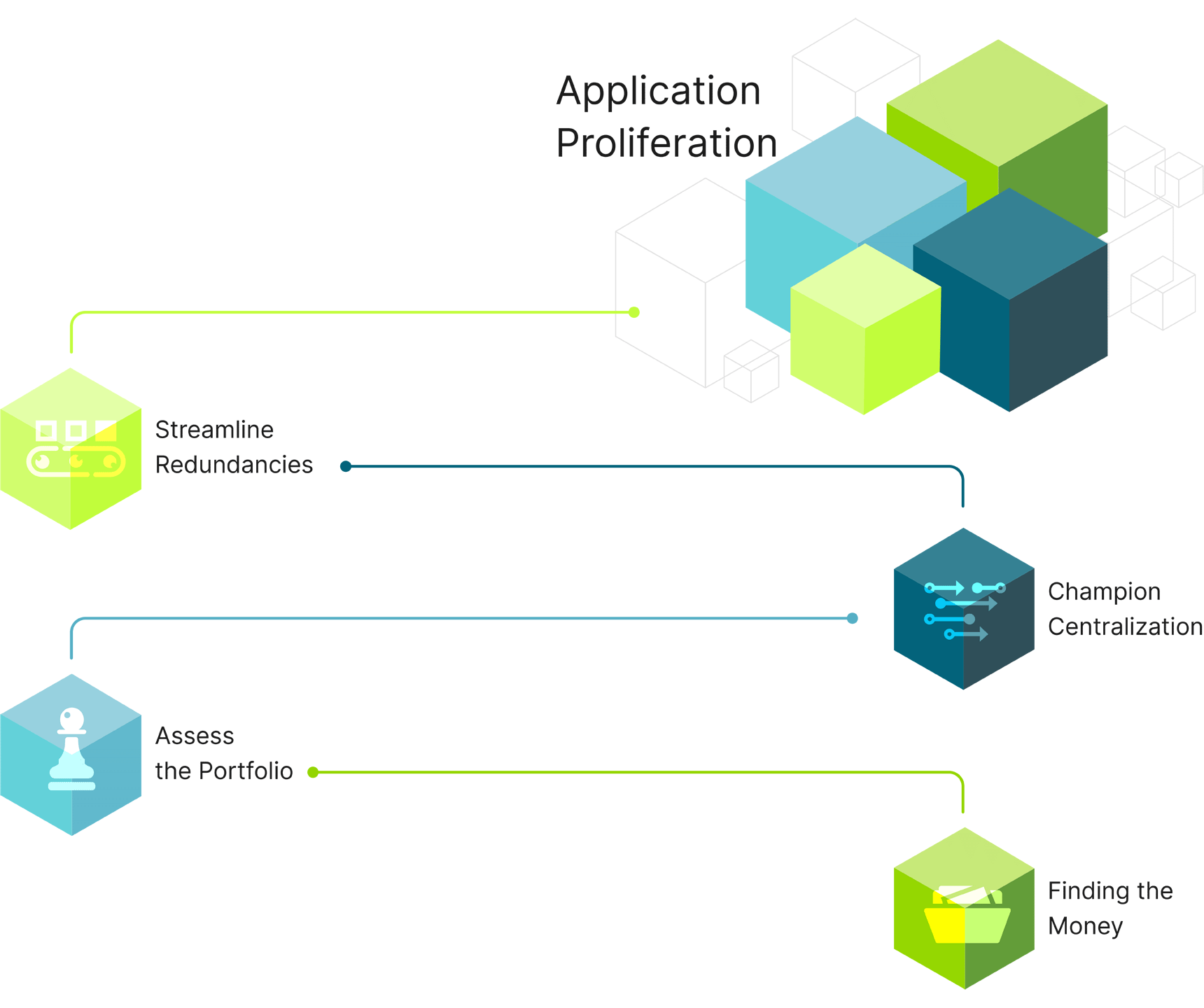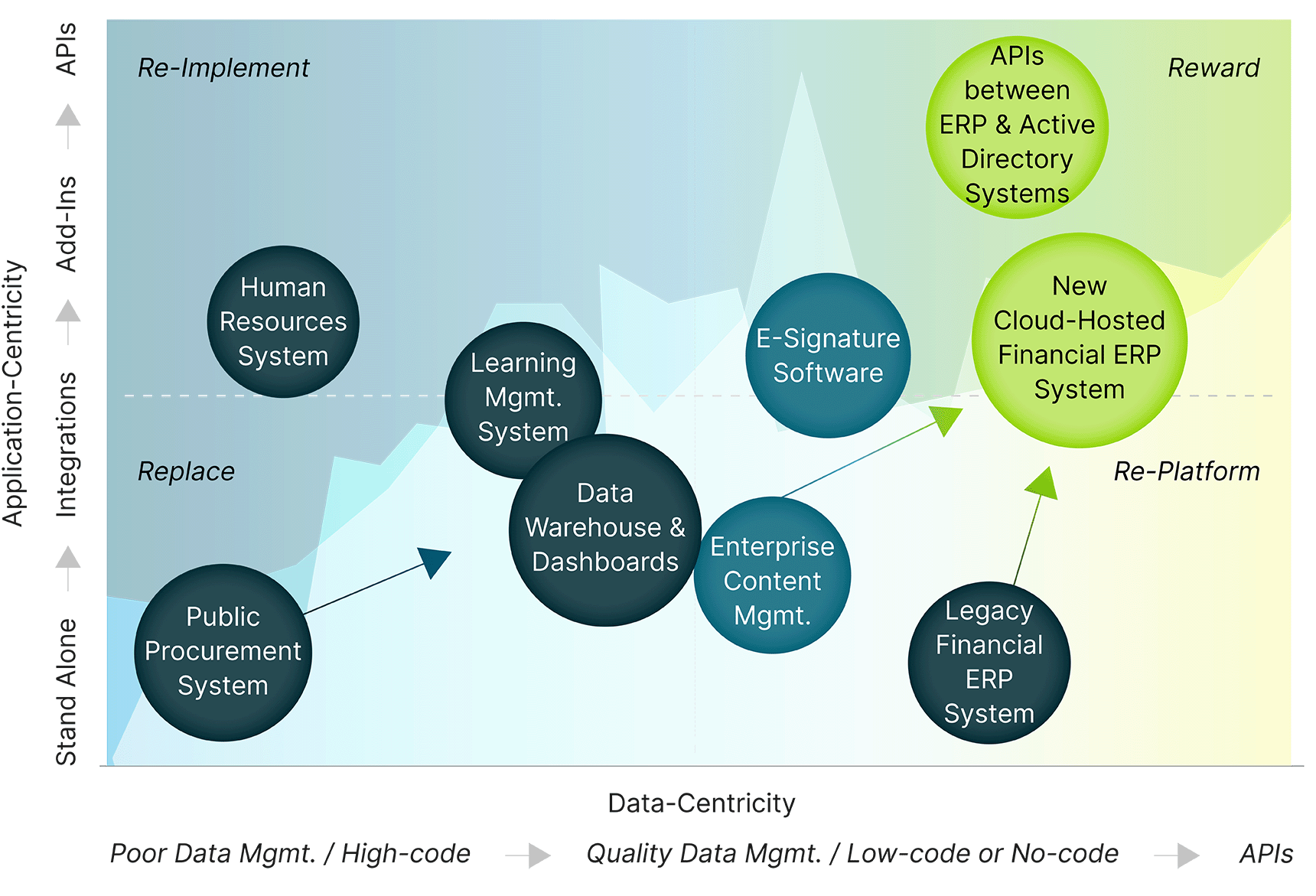 Search
Search


By Robert McNamara
Enterprise and government IT application environments are challenged by the burdens of old or underused software. Optimizing application portfolios is key to freeing up human, financial, and infrastructure resources.
Many organizations’ digital transformations have witnessed considerable additions to their application portfolios in recent years. But what happened to all of the legacy applications that these new applications were expected to replace? A large percentage of organizations still have those applications. Or, if they did retire the applications they intended to replace, they have since brought in additional solutions with overlapping functionalities. For these and a number of other complex reasons, application portfolios have swelled in size in recent years. Not only does that cost organizations money in licensing and maintenance costs, it also leads to IT workforce burnout and the inability to meet other IT strategic and operational goals.
When a considerable amount of IT staff time is spent maintaining or renewing software that is no longer needed or is insufficiently used, that impacts an organization’s ability to support the implementation of software that is far more critical to its mission. It also makes it harder to afford much-needed large-scale technology investments and to retain and upskill the staff that would implement them. Optimizing application portfolios is critical to addressing these issues—and to setting organizations up for long-term success.
In this three-part series, we are taking a comprehensive look at application rationalization by examining the impacts of burnout from application proliferation, how to right-size applications, and what organizations can do to prevent application proliferation. In this article, we will focus on helping you create a strategy to right-size your application portfolio.
Application rationalization is essentially a strategic evaluation and roadmap development for your application portfolio. It involves coming up with a process for dealing with application redundancy, improving communication around application implementation and adoption, and creating a rubric to decide which software to discontinue. It also entails properly resourcing the work of supporting and retiring applications.

Often, application proliferation leads to inefficiencies because it creates silos that hinder team members’ collaboration. The process of streamlining redundancies is a critical part of optimizing application portfolios. This involves three steps:
Deciding which primary software to use can be accomplished best via comparisons of data and functionality visualizations. In many organizations, familiar examples of overlapping software are for things like content management, ERP systems, CRM solutions, e-signatures, workflow tools, and project management. A visualization can help end users better understand how they use these applications.
Creating simple and impactful guidance for which applications to use, as illustrated below, can help an organization begin retiring outdated practices and systems to reduce rework (such as, here, discontinuing saving files to individuals’ devices or shared network folders and discontinuing the emailing of attachments instead of links).
This kind of collaboration is critical to understanding end-user needs and gaining buy-in for retiring applications. It is crucial that the IT function champions application rationalization through a collaborative culture for gaining buy-in and facilitating changes. By working with businessowners, establishing and maintaining accountability, and better understanding end-user adoption and expectations, organizational application inefficiencies and overlaps can be identified and rectified.

One of the challenges of application proliferation is that it can create data duplication and silos that result in wasted time spent integrating and analyzing redundant or disconnected data. Taking a data-centric approach focuses on greater data quality controls and modern data and analytics architectures to save time and improve data accuracy.
A data-centric approach faces obstacles from applications that do not yet have interfaces or are difficult to interface with. A longer-term strategy would be to replace them with core functionality or add-ins to other existing systems or newer, data-centric software. Centralizing data into data-centric applications does not just make data more accessible enterprise wide, it also breaks down silos, adds greater transparency, and makes data more portable for analytics or future migrations to newer solutions.
Evaluators can create a scorecard to assess applications based on themes such as their business value and technical fit. They can plot them on a graph, even focusing on particular themes such as their level of application vs. data-centricity, as shown in the graphic below, to visualize which applications to reward, retire, replace, or re-platform.
For instance, if an organization is about to implement a new enterprise resource planning (ERP) system, it might consider replacing its stand-alone procurement system and enhancing application-centric e-signature and content management systems with interfaces to the ERP. To do this effectively, IT must work to get buy-in from executives, champions, and end users. Leadership and IT must maintain a collaborative communication culture during the transition to address concerns, deal with non-adherence, and approve the retirement of systems post-transition.

The process of identifying redundant or unused software to retire, coming up with a strategy, and getting buy-in is time consuming. However, that is just the start of the application rationalization process. It also involves data migration, training on new software, creating and enforcing usage guidelines, and implementing new solutions.
Removing unused or redundant applications that an organization continues to renew takes work to decommission. Over time, this debt accumulates until it ends up redirecting a large percentage of IT budget and staff time to maintaining the redundant or underused applications. At that point, the issue becomes even more costly to address. It is critical that organizations devote ongoing resources to application rationalization to ensure that they do not accumulate software debt.
Application rationalization involves balancing the benefits with the required investments:
Benefits
Required Investment
Optimizing an organization’s application portfolio is critical to meeting customer or constituent service expectations, maintaining technological and operational agility, optimizing costs, reducing IT workload, and increasing the success of future technology implementations. It can also save end-user time by creating clarity around which applications to use to optimize collaboration, productivity, and data management. While the process will require investment of scarce resources, successful rationalization will generate licensing, maintenance, and support cost savings that can be used to modernize the IT environment and address technical debt.
Guidehouse has extensive experience in guiding organizations through the application rationalization strategy and implementation process. We have deep expertise in a wide range of segments and industries and have successfully optimized application environments in organizations of different sizes. Because we look beyond technology, we are able to navigate the complexities of gaining stakeholder buy-in and enabling change that realizes results.
In our final article in this series, we will explore how organizations like yours can prevent application proliferation and accelerate the IT modernization journey.
This article was co-authored by Robert McNamara and Jenny Wein.
Guidehouse is a global advisory, technology, and managed services firm delivering value to commercial businesses and federal, state, and local governments. Serving industries focused on communities, energy, infrastructure, healthcare, financial services, defense, and national security, Guidehouse positions clients for AI-led innovation, efficiency, and resilience.